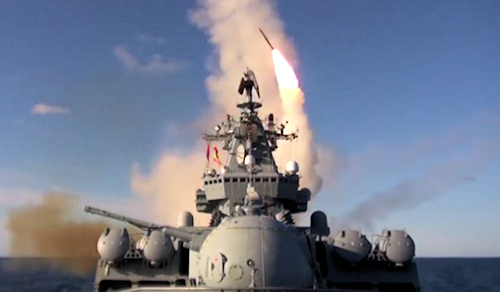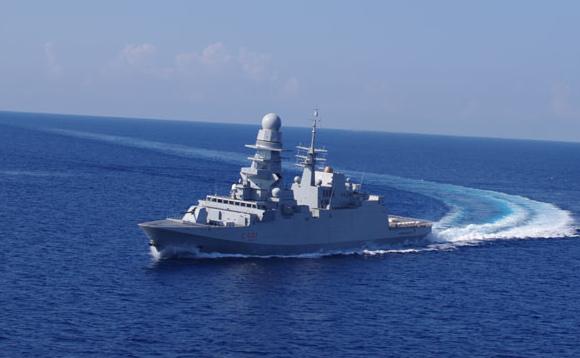In an interview in the newspaper la Repubblica, the Chief of Defense Staff, Admiral Cavo Dragone, told of recent events in the Adriatic Sea, which saw some naval units of the Russian Navy as protagonists.
Our Navy has kept "under control" a Russian fleet that has gone as far as the Abruzzo coast.
According to the head of SMD, the Russian ships did not want to block the Otranto Canal but to carry out a patrol operation. Adding that “It was not a confrontation between NATO and the Russians or between the Americans and the Russians (in the Mediterranean there is the VI Fleet of the US Navy, NdA). It was the Italian forces that took the countermeasures ".
Also according to Admiral Cavo Dragone the Navy had “A fluid, textbook reaction, ordering what is called a search operation. Two FREMM frigates, the most modern in our fleet, have moved. The Bergamini on the Russian fighter Admiral Tributs; the Marceglia on the cruiser Varyag. The P-72A aircraft of the 41st flock flew over them non-stop. Then the Libeccio frigate also arrived. In short, we didn't let go of them for a moment ".
In addition to the Italian device, the submarine also arrived Longobardo. While the frigate joined the small Russian fleet Admiral Grigorovich.
We analyze the Italian and Russian naval units
The hunt Tributes it was conceived as an antisom unit. In fact, its main armament consists of antisom missiles (Metel-U), 533 mm torpedoes (SET-65) and 213 mm antisom rockets (RBU-6000). In addition to this it embarks eight vertical launchers for 3K95 surface-to-air missiles Kinzhal (SA-15). In addition, two towers with 100 mm pieces are installed in the bow.
The multi-role frigate Bergamini, the first FREMM to enter the Italian Navy, has as its main armament a 127/64 mm LW OTO Melara cannon (still without Vulcano ammunition), a Super Quick 76/62 mm (still without Davide / Dart ammunition) and 16 VLS A50 cells for Aster-15/30 surface-to-air missiles (however the number of missiles embarked should be equal to half of the cells).
 The cruiser Varyag is a missile platform. Its anti-ship armament consists of 16 P-1000 supersonic missiles, with a maximum range of over 800 km and a 130 mm twin tower. For anti-aircraft defense, it embarks 64 S-300F long-range surface-to-air missiles and 40 OSA-M short-range missiles.
The cruiser Varyag is a missile platform. Its anti-ship armament consists of 16 P-1000 supersonic missiles, with a maximum range of over 800 km and a 130 mm twin tower. For anti-aircraft defense, it embarks 64 S-300F long-range surface-to-air missiles and 40 OSA-M short-range missiles.
As regards the Marceglia, the equipment on board is the mirror image of Bergamini.
To date, it does not appear that any of the 8 FREMMs in service have ever launched an anti-ship missile (Teseo Mk2 / A).
The only naval unit, added to the Italian device, to carry anti-ship missiles is the frigate Libeccio (class Mistral). Launched in 1981, she had to go in decommissioning, together with the last two of the class Mistral still active (Zephyr e Grecale), with the entry into service of the last two FREMMs (White e Schergat's target). However, the sale of these two units to Egypt meant that the Mistral were still to remain in service.
Il Libeccio, in addition to the 127/54 mm OTO piece, it embarks 4 containers / launchers for old generation Otomat / Teseo missiles that need the assistance of an AB-212 to hit targets beyond the horizon line (TG2).
The frigate Grigorovich, which came to reinforce the Russian device, embarks eight 3M54 supersonic missiles Kalibr, with anti-ship capabilities e land attack. In the future, this unit could also embark the new 3M22 hypersonic missiles Zircon.
The Russian naval units certainly had no intention of blocking the Otranto Canal, nor of hitting American bases on Italian territory. The Navy did what it could, which was to monitor Russian ships but if the situation worsened ... the XNUMXth Fleet would intervene with the aircraft carrier Truman (90 aircraft on board) and his own carrier strike group composed of two class cruisers Ticonderoga, two class fighters Burke and one or two nuclear-powered submarines (SSN) class Virginia.

Photo: Navy / MoD Russian Fed / US Navy












